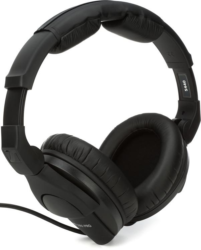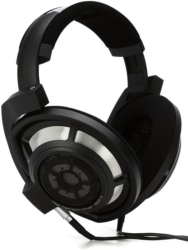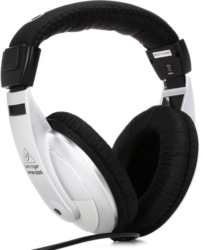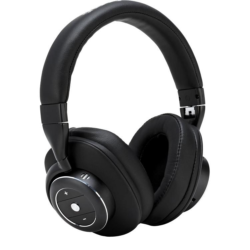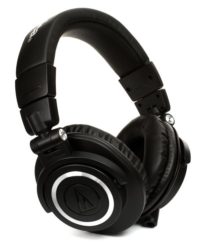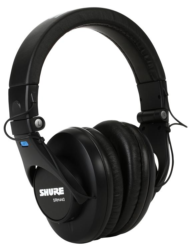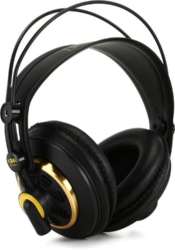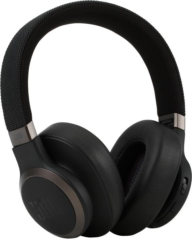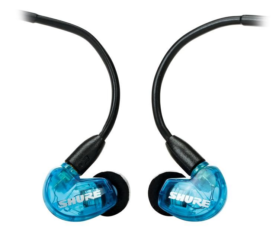Music plays a role in everyone’s life, whether it’s a person’s career or hobby. For music enthusiasts who always have something playing, a trusty pair of headphones are a necessity. Headphones allow you to take the music with you or prevent you from annoying your roommates. If you make music, they’re essential for mixing. You probably already have an arsenal of headphones, but if you’re ready for a new pair, we have a list of the best pairs that are perfect for music.
First, we’ll go through the basics of headphones so you can know what to look for, and then we’ll get into our top 10 reviewed headphones. Then, we’ll take a closer look at the ins and outs of headphones and end with some common questions surrounding headphones.
- What to Look For in Headphones for Music
- Top 10 Best Headphones for Music 2025
- 1. Best Overall Headphones: Sennheiser HD 280 Pro
- 2. Best Premium Headphones: Sennheiser HD 800 S
- 3. Best Budget Headphones: Behringer HPM1000
- 4. Best Bluetooth Headphones: PreSonus Eris HD10BT
- 5. Best Multipurpose Headphones: Audio-Technica ATH-M50x
- 6. Most Portable Headphones: Shure SRH440
- 7. Best Headphones for Long Listening: AKG K240
- 8. Most Comfortable Headphones: Beyerdynamic DT 770 PRO
- 9. Best Bluetooth Headphones for Extended Listening: JBL Lifestyle Live 650BTNC
- 10. Best Sound-Isolating Earphones: Shure SE215 Earphones
- FAQs
- Everything You Need to Know About Headphones
- Final Thoughts
What to Look For in Headphones for Music
Many people don’t understand what goes into a pair of headphones. The cheapest pair at your local department store won’t sound the same as a pair that costs a couple of hundred dollars. That’s because the cheap pair doesn’t have the same high-quality components. Besides the technical pieces on the inside, the outside of the headphones matter, too.
Headphone Components
Headphones must have certain parts to function correctly, and those parts will determine how well the music is played. High-quality components typically mean a higher price tag, but it’s well worth the investment for audiophiles. Low-end headphones will work fine for casual listeners, but there are still some surprisingly great yet cheap options on the market.
The following components are almost always found with every set of headphones, and we’ll dig in deeper below.
- Ear cups: Ear cups are what differentiate headphones and earphones. They sit on or around your ears. The ear cups can be open, semi-open, or closed, which affects comfort and sound.
- Driver: The driver is the speaker and greatly affects how the music sounds. Drivers come in different sizes, and bigger definitely means better.
- Sound quality: Sound quality is subjective, but it’s affected by the driver, impedance, and frequency response. Headphones usually have a low impedance and narrow frequency response range, which is suitable if your music source comes from your smartphone or laptop. You might be disappointed with the sound quality if your source comes from something more powerful.
- Microphone: Headphones that come with a cable don’t typically have a microphone, but Bluetooth headphones do. Microphones are becoming more common with headphones since many listeners use music apps on their phones. Having a microphone will allow you to accept calls easily without needing to disconnect the headphones first.
- Power supply: Headphones that utilize an audio jack and cable don’t need to be charged. Bluetooth headphones do, however. They usually charge with a USB cable and only need a few hours to give you anywhere from half of a day to almost two days worth of listening time.
Types of Headphones
There are several different types of headphones on the market that you should consider before you make a purchase. Many of these types overlap or serve as subcategories.
Headphones vs. Earphones
Avid music listeners typically prefer headphones since they often produce better sound quality. They’re more comfortable and safer to use than earphones, and they are better to use in professional settings.
Earphones, which are also called earbuds, go inside the ears so they’re much smaller than headphones. Because of their size (or the lack of), the sound they produce isn’t as impressive as headphones, although earbuds these days have made considerable improvements. Because of their lack of sound quality, they aren’t usually used by audiophiles or musicians because they can sometimes distort the music.
On-Ear, Over-Ear, and In-Ear
- On-ear: On-ear headphones have ear cups that are flat and sit on top of your ears. They can get pretty uncomfortable after just a couple of hours since they press against your ears. They don’t offer much in terms of noise-canceling properties, so they’re a good choice if you need to be able to hear your surroundings.
- Over-ear: These ear cups will go around your ear. A cushion will press against your head and the ear cup will engulf your ear. They’re arguably the most comfortable type of headphones, and you can easily wear them for hours at a time. They have noise-canceling capabilities, so if you want to block out your surroundings, these are the way to go.
- In-ear: The in-ear style is exclusive to earphones. They’re uncomfortable for many people so they can’t be worn for long periods of time. Earphones are known to cause infections since placing them in your ear introduces germs and dirt. Despite their downsides, they’re loved by many because of their portability and sound-isolation abilities.
Open-Back, Semi-Open, and Closed-Back
Headphones – not earphones – are classified as open, semi-open, or closed. This is referring to the back of the ear cup. Closed headphones don’t allow sound to leak out. That sounds like a great thing, but surprisingly enough, it can negatively affect the sound by causing false low frequencies since the sound is trapped in the same space.
Open-back headphones allow sound to escape. This prevents false low frequencies from occurring, but that does mean that others around you can hear what you’re listening to. If you’re still secretly listening to the soundtrack of that children’s movie you loved, this might be a problem, but at least you’ll hear it like never before.
Semi-open is a happy medium. Some sound is able to escape, so you won’t experience as many false low frequencies, and others around you won’t be able to hear your music as much as they would if they were open-back.
Although it’s not always the case, closed-back is typically over-ear style, and semi- or open-back is typically on-ear.
Corded vs. Wireless
Corded headphones use a cable and audio jack to connect to devices to receive their sound and power. Headphones meant for audiophiles or musicians may come with several different cables and audio jack adapters to fit with any device or instrument.
Wireless headphones are battery operated and use Bluetooth to connect to devices. If your device doesn’t have Bluetooth capability, then you won’t be able to use these. Most, if not all, smartphones and laptops come with Bluetooth capability, so casual listeners won’t have any problem using this type of headphones.
Now that you know what to look for let’s get into our top ten picks for headphones that are ideal for music.
Top 10 Best Headphones for Music 2025
1. Best Overall Headphones: Sennheiser HD 280 Pro
Why we like it:
These headphones offer high-quality sound at a mid-range price, so audiophiles on a budget can get the quality they seek without the price tag.
Quick Specs:
- Ear cup style:Over-ear
- Ear cup type:Closed-back
- Driver size:40mm
- Impedance:64 ohms
- Frequency response:8Hz-25,000Hz
- Noise-canceling:Yes
- Colors available:Black
These headphones are sure to please most people. They’re a bit more expensive than what the typical casual listener will pick up at a department store, but the price is nowhere near what professional musicians typically buy. You may be spending less money than high-end headphones, but it doesn’t sacrifice too much sound quality. An annoying aspect is that you can’t remove the cable, so if the cable gets damaged, you’ll have to replace the entire product.
These will fit around your ear so that it’s inside the headphone, and you’ll find that it’s roomy and comfortable when you wear them. They even cancel out noise to make your listening experience even more enjoyable. The part of the headband that sits on top of your head is padded, so you’ll be able to wear them for hours on end.
Unfortunately, you may find that these headphones squeeze your head a little too much the first few wears, so you’ll need to break them in. Despite this, they’re incredibly durable and you can expect to use them for many years to come.
Pros
- Great noise cancellation
- Will last for several years
- Roomy ear cups
Cons
- Cable can’t be removed
- Might be a little tight for the first few wears
Why we like it:
These high-quality headphones give you exactly what you pay for. If you’re looking for a crisp sound that immerses you in the music, these are for you.
Quick Specs:
- Ear cup style:Over-ear
- Ear cup type:Open-back
- Driver size:56mm
- Impedance:300 ohms
- Frequency response:4Hz-51,000Hz
- Noise-canceling:No
- Colors available:Black
The price tag may be more than some people’s monthly rent, but rest assured that this set of headphones won’t disappoint. With the largest dynamic driver available, it offers incredible impedance and frequency response so you’ll be able to enjoy any type of music in the way it was intended to be heard. We talk about these things in greater detail below.
If you live with roommates or family, these might not be the best choice. They’re open-backed headphones, which means the people around you will be able to hear what you hear and there isn’t any noise cancellation. The open backs are what allows the music to be played clearly without sound distortion. You can hear bass notes clearly and it causes the headphones to sound as if you’re in a surround sound environment.
These headphones are a sizable investment, but music enthusiasts and musicians alike will love these and the quality they offer.
Pros
- Plays music accurately
- Doesn’t boost the bass
- Makes you feel immersed in the music
Cons
- Steep price tag
- Can’t cancel noise
3. Best Budget Headphones: Behringer HPM1000
Why we like it:
These aren’t your typical affordable headphones. They offer surprisingly great sound quality for the price tag and don’t cause much sound distortion.
Quick Specs:
- Ear cup style:Over-ear
- Ear cup type:Closed-back
- Driver size: 40mm
- Impedance:32 ohms
- Frequency response:20Hz-20,000kHz
- Noise-canceling:No
- Colors available:Silver
The price of these are more like what you’d find in a department store, but they’re still good-quality headphones that give you more for your money. These headphones will struggle to produce deep bass notes since the frequency response only goes as low as 20Hz, but it won’t cause them to rattle and distort the sound.
Admittedly, these aren’t the most comfortable headphones on the market, but they do have padded headband and ear cups. The foam padding on the inside of the ear cups are prone to flaking and crumbling, but you could easily buy replacement pads online.
These are ideal for casual listeners who want a good listening experience without the price of one. Audiophiles who obsess over sound quality may be disappointed with this product, but they’d still be good to keep around as backups.
Pros
- Budget-friendly
- Good performance compared to more expensive models
- Great bass without overdoing it
Cons
- Not the most comfortable
- Foam pads flake easily
4. Best Bluetooth Headphones: PreSonus Eris HD10BT
Why we like it:
Many smart devices require an adapter since they said farewell to the audio jack, which makes Bluetooth headphones a necessity these days. These noise-canceling headphones can connect to any device and can last for up to 16 hours of non-stop listening.
Quick Specs:
- Ear cup style:Over-ear
- Ear cup type:Closed-back
- Driver size:40mm
- Impedance:16 ohms
- Frequency response:20Hz-20,000Hz
- Noise-canceling:Yes
- Colors available:Black
Sometimes you don’t want to be leashed to your device with a cable, and that’s where these Bluetooth headphones come in. They’re cushioned so you can wear them for several hours and have a long battery life of up to 16 hours. The control buttons on the sides of the ear cups allow you to change the volume and answer your phone. These headphones are noise-canceling so they’re great to take on the bus or to the library.
They have a built-in microphone which many corded headphones don’t offer, so that’s a bonus. But, the microphone is a bit too far away from your mouth, so the person on the other end might have a hard time hearing you.
In terms of sound quality, these will be more appreciated by casual listeners. It has a low impedance and a rather narrow frequency response range.
Pros
- Noise-canceling
- Up to 16 hours of battery life
- Can answer phone calls with the headphones
Cons
- Microphone far from your mouth
5. Best Multipurpose Headphones: Audio-Technica ATH-M50x
Why we like it:
These headphones come with three different cables and an audio jack adapter so you can listen to music with any device.
Quick Specs:
- Ear cup style:Over-ear
- Ear cup type:Closed-back
- Driver size:45mm
- Impedance:38 ohms
- Frequency response:15Hz-28,000Hz
- Noise-canceling:No
- Colors available:Black, white
Music lovers who are beginning to dabble in making their own music will love these headphones. They’re great for listening to music, but the three cables and audio jack adapter they come with allows you to plug in to just about anything, whether it be your phone, computer, or instrument. It even comes with a bag to keep everything in so you can keep the cables out of your box dedicated to mystery cords. (Of course you have one. Everyone does.) The headphones even fold up so you can store them in there, too.
The driver is a bit bigger than what most other mid-range price headphones offer, so the frequency response range and impedance is more impressive. This will allow bedroom musicians to have an enjoyable experience without having to spend a bunch of money.
Although they have great sound quality, the headphones do lack in comfort and durability. They should stay in one piece for a few years, but you’ll probably need to make a repair at some point. The headband lacks padding, so it gets uncomfortable on the top of the head since it creates pressure.
Pros
- Folds up for easy storage
- Comes with a bag for all the cables
- Includes a short cable to use with mobile devices
Cons
- Not much padding on the headband
- Not durable to last for more than a few years
6. Most Portable Headphones: Shure SRH440
Why we like it:
These headphones have a locking mechanism to prevent the cable from getting pulled out of the headphones unexpectedly. You can take these with you and not have to worry about the cable snagging on things and ripping the cable out.
Quick Specs:
- Ear cup style:Over-ear
- Ear cup type:Closed-back
- Driver size:40mm
- Impedance:44 ohms
- Frequency response:10Hz-22,000Hz
- Noise-canceling:No
- Colors available:Black
Not everyone is graceful. If you know something about getting your headphone cable caught and and getting yanked out of the headphones, then you’re going to appreciate this pair. It has a locking audio jack that will keep the cable in place. If you’re clumsy or have small children or intrusive pets, these will prevent the music session from getting interrupted.
The sound quality of these headphones are all the more reason to consider these. They can handle frequency responses as low as 10Hz which is pretty impressive for this price point. These aren’t capable of canceling noise, so that might be a downside for some.
Really, the only sin is that the padding on the ears is a bit too stiff. They’ll be slightly uncomfortable and prone to cracking.
Pros
- Sound quality exceeds price point
- Locking audio jack
- Cable can be replaced if damaged
Cons
- Stiff ear padding can be uncomfortable
7. Best Headphones for Long Listening: AKG K240
Why we like it:
These cushioned semi-open headphones allow for some air to reach your ears which is perfect for long listening sessions on Fridays when multiple artists release new albums.
Quick Specs:
- Ear cup style:Over-ear
- Ear cup type:Semi-open
- Driver size:30mm
- Impedance:55 ohms
- Frequency response:15Hz-25,000Hz
- Noise-canceling:No
- Colors available:Black
Long music sessions require ultimate comfort, which this pair certainly provides. They’re lightweight and have a semi-open design that allows your ears to “breathe” which will prolong the amount of time you’re able to wear them.
The semi-open ear cups are great for audiophiles but might not be ideal for casual listeners. They improve the sound quality, but they cause some of the sound to leak out so that others around you will hear what you’re listening to. However, it won’t be super loud so if someone is watching TV, they shouldn’t be able to hear anything. This means that they can’t cancel out noise.
The driver size is smaller than most of the headphones we’ve mentioned already, yet they have better impedance and frequency response range. You can thank the semi-open ear cups for that.
Pros
- Lightweight for comfort
- Incredibly clear sound
- Semi-open design allows ears to “breathe”
Cons
- Some sound will leak out and can be heard by others around you
- Allows you to hear background noises
8. Most Comfortable Headphones: Beyerdynamic DT 770 PRO
Why we like it:
These headphones are far more comfortable than many other pairs since they have a fabric lining and foam padding.
Quick Specs:
- Ear cup style: Over-ear
- Ear cup type: Closed-back
- Driver size:45mm
- Impedance:250 ohms
- Frequency response:5Hz-35,000Hz
- Noise-canceling:Yes
- Colors available:Black
These headphones are a bit steep on their price tag, but they’re worth the investment. The cushioning around the ears is made with fabric, so it won’t be prone to cracking or flaking. They’re over-ear headphones, so the fabric won’t be on top of your ear which will prevent you from getting too sweaty.
The 45mm driver allows the headphones to have an impedance of up to 250ohms and a frequency response as low as 5Hz. If this is so great, why’d we give it a 4-star rating? Well, you have to have an amplifier if you want to make use of it’s impedance abilities. For casual listeners, who just want to have a great experience, these headphones are a bit more trouble than they’re worth.
Pros
- Soft padding that won’t crack
- Wide range of sound
- Excellent noise-canceling abilities
Cons
- Headphone amplifier needed to reach 250 ohms
9. Best Bluetooth Headphones for Extended Listening: JBL Lifestyle Live 650BTNC
Why we like it:
If you can’t live without music, these headphones are for you. It only takes two hours to charge the battery to full capacity and it will give you up to 30 hours of listening time.
Quick Specs:
- Ear cup style: On-ear
- Ear cup type:Closed-back
- Driver size: 40mm
- Impedance:32 ohms
- Frequency response:16Hz-20,000Hz
- Noise-canceling:Yes
- Colors available:Black
If you want to have the ability to put headphones on when you walk outside your door and keep them on all day while you’re out, these are for you. They’ll reach full charge in just two hours and will give you up to 30 hours of listening time. They have active noise canceling that you can turn on, too. But, if you use this feature, the headphones will only last up to 20 hours per charge.
This pair comes with a charging cable and an audio jack cable, so if you’re unable to use your charger, you can use them as corded headphones instead. It’s super convenient, but they don’t’ have a case or bag to keep the cables in, so you risk getting them mixed up with all your other cables.
The sound quality isn’t as capable as other headphones. The impedance is only 32 ohms and the frequency response range is a little slim compared to others. Still, these headphones will be appreciated by many casual listeners.
Pros
- Up to 30 hours of listening time
- Comes with a cable to connect to devices
- Super quick charge time
Cons
- Sound isn’t as powerful as other headphones
- Only 20 hours of listening when using noise-canceling
10. Best Sound-Isolating Earphones: Shure SE215 Earphones
Why we like it:
If you prefer earphones instead of headphones, are high-quality with a decent price tag. They isolate sound and have an enhanced bass so you can get headphones-quality sound.
Quick Specs:
- Ear cup style:In-ear
- Ear cup type:N/A
- Driver: 1 dynamic driver
- Impedance:17 ohms
- Frequency response:22Hz-17,5000Hz
- Noise-canceling:Yes
- Colors available:Black, blue, clear
Many people use the term “headphones” interchangeably between actual headphones and earphones, although there’s a big difference. We added a pair of earphones on this list because they earn a spot to join the ranks with traditional headphones.
These earphones have a dynamic driver that gives them decent impedance and frequency response range. Earphones typically have lower capabilities than headphones since they have incredibly small drivers. Despite that, these will sound great since they take the sound straight to your ear canal and block out noise.
The earphone wires go over your ear so they’ll stay in place, which is great if you stay active. The bass in songs will sound pretty clear and they don’t needlessly boost it. They come with several earpiece sizes to choose from, but they’re difficult to change out.
Pros
- Wires go over the ear to stay in place
- Comes with several earphone piece sizes to find the fit you need
- Clear bass without bass boosting
Cons
- Difficult to remove the earpieces
FAQs
Earphones and earbuds are the same thing – they’re the in-ear devices that deliver the sound directly into your ear canal. They’re not the same as headphones. Headphones have the bigger earpads that sit on or around your ear with a band that go over the head. Remember: earbuds go in the ear and headphones go over the head.
“True wireless headphones” is a bit misleading – they don’t exist, but true wireless earphones do. This means there isn’t any kind of wire that connects each individual earphone that goes into your ear. The ear cups of headphones are attached to each other with the headband. There’s no way to attach an Ear cup to your head with a headband.
Headphones can cause damage to your ear if music is played too loudly or to your skin if you wear them for too long. If you wear headphones while working out, sweat can cause bacteria to build up. You might notice acne around your ears and in worst case scenarios, skin infections.
Headphones are considerably safer than earphones because they give your ears some breathing room. Earphones send sound straight to the canal and blocks up airflow in the process, which can cause ear infections. Over-ear and on-ear headphones allow for breathing room. You’re less likely to injure your eardrum with headphones.
Studies show that eardrum damage can happen in less than an hour if the sound volume is over 85 decibels, which is about the volume of a lawn mower. If you listen at a safe volume, you can use headphones for an hour or two at a time. You should take a break between sessions to give your ears some down time.
Everything You Need to Know About Headphones
There are a lot of options to choose from when it comes to headphones. If you’re still undecided, here’s our in-depth guide to all the little pieces that make up a pair of headphones. We’ll end with some frequently asked questions to make sure we cover every last question you might have.
Ear Cups
ear cups are essential to every pair of headphones. They house the brains of the device that create the sound while making them comfortable to wear. The main component inside the Ear cup is the driver, but there will also be wires and coils. Wireless headphones have circuit boards and a battery as well as a battery.
The earpads are just as essential as the cups that house the driver. They’re what makes or breaks a pair of headphones. If the earpads are uncomfortable, it can make the entire product not worth using. They also determine whether the headphones are on-ear or over-ear.
Earpads need to be cared for so they can last a long time. If you wear your headphones in hot weather or when you’re active, they can collect sweat and get dirty. You can remove the pads and wipe them with a damp cloth and leave them to air dry. If the padding has become flat, smell bad, has cracks, or no longer fits like they used to, it’s time to replace them.
Sound Quality
Sound quality is subjective. One person might think a pair of headphones sounds crystal clear while another person might say otherwise. While it might be in the ear of the beholder, sound quality is determined by the driver and its abilities.
Drivers
A driver is electromagnetic and creates sound with electric signals. Without it, headphones wouldn’t be able to make any sound at all. Drivers come in different sizes and bigger usually means better in most cases. There are four types of drivers that all work differently:
- Dynamic: Dynamic drivers are what you usually find in most headphones made for casual listeners. They’re affordable for manufacturers to make, small, and they don’t need to receive power from an external source. They’re the standard driver that get the job done, and they do it pretty well for their price.
- Balanced armature: These drivers are smaller than dynamic and are mostly used for in-ear earphones. They’re great for low frequency sounds and will sound pretty impressive to most casual listeners. Audiophiles who are used to high-end headphones might not be as impressed.
- Planar: Planar drivers are more expensive and cause headphones to look rectangular rather than circular. They’re usually saved for higher quality headphones since their sound reproduction is more accurate than dynamic drivers. Some in-ear earphones are starting to use this type of driver, too.
- Electrostatic: This kind of driver will be in expensive headphones because they’re expensive to make, don’t distort the music in any way, and require a specific amplifier. Casual listeners won’t have a need for these headphones since they’re so expensive and require additional equipment just to use them. An audiophile with an interest in creating their own music might be interested, however.
Impedance
As you shop around for headphones, you’ll see something listed called impedance. It’s technical enough that casual listeners don’t know what it is or why it matters, but not so technical that it should be ignored completely. If you’re an audiophile-to-be, it’s important that you learn the significance in the early stages of your musical interest. If you’re a casual listener, you’ll be able to tell your friends why “these are the best headphones I’ve ever bought.”
The definition is a bit tricky, but it’s basically this: impedance is what controls the flow of the electrical current. Drivers have currents going through them, and the audio source does, as well. Impedance between the headphones and the audio source need to be similar for the music to sound correct. If the impedance of the headphones and source don’t match, the tone of the music won’t sound right and won’t be as powerful.
Impedance is measured in ohms which is written as the symbol Ω. Most headphones will have an impedance between 8 and 600 ohms. As you can imagine, the higher the impedance, the better the sound. 32 ohms is becoming more common in headphones. It may sound low, but with dynamic drivers, it creates an impressive sound at an affordable price.
Frequency Response
Frequency response is the range of sounds that come through the driver. That’s the bass, mids, and treble. They’re measured in hertz (Hz) and are another aspect of headphones that are ignored by most casual listeners.
If you’ve ever heard a booming song and turned up the volume so the speaker would rattle and said, “that’s good bass,” then you know a little bit about frequency response already. Bass is in the lower range of frequencies. Many headphones, especially earphones, are unable to produce powerful low frequencies, causing the music to sound flat or distorted.
Many audiophiles don’t like a booming bass because it detracts from the mid-range and treble sounds. If you want to hear all of the sounds in music, you need to find a pair of headphones with a wide frequency response range.
The Sennheiser HD 800 S headphones have an impressive range of 4Hz-51,000Hz, or 51kHz to simplify it. These headphones will allow for all ranges of sound to be heard clearly without distortion. (We’re sorry to say that a vibrating car is indeed sound distortion, as invigorating as it may be.)
Final Thoughts
Music is essential in many people’s lives, whether they’re musicians or casual listeners. Wherever you may fall on that scale, we hope that our list will help you find the perfect pair of headphones so you can continue to jam to the beats, appreciate the classics, or enjoy the oldies.

